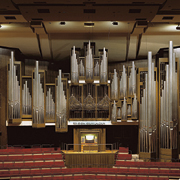[10.10.2012] Thomas Daniel Schlee’s Rufe zu mir for organ and orchestra will be premiered in February at the Gewandhaus Leipzig, conducted by Riccardo Chailly with Michael Schönheit as soloist, and receives its Austrian premiere shortly afterwards in Vienna.
A “symphonic scene” is how Thomas Daniel Schlee describes his concertante music for the Gewandhaus Orchestra and solo organ. Its title, Rufe zu mir, places a sacred thought as a poetic idea at its centre, for the “association with the sacred”, says the composer, “is always present with the organ, even when you are writing for the concert hall”. Schlee wants to understand [this connection] here “rather as a magical power and not to enshroud it”, on the contrary, out of this he fashions a thematic starting point for the relationship between solo instrument and orchestra: “Rufe zu mir, dann werde ich dir antworten” (Call to me, and I will answer you) after Isaiah sets both the poetic mood and the programme. The omnipresence of God, personified in the solo voice, is developed into an unexpected, almost dramatic scenario. As soon as the conductor enters, and over the first minutes of the quarter hour composition, a low pedal note is subliminally present, which, like the short combined passages on the organ, is barely perceptible. The beginning consists of invocations in many and diverse forms from which a “de profundis” in the orchestra, that of mankind, symbolizes the world.
Schlee sees a profoundly human constellation in this tension-laden beginning, in which there is (supposedly) no answer to the many different calls. It comes meanwhile as an overwhelming moment out of nothing: a powerful E major chord at triple fortissimo, extended at a slow tempo. Picking up on the “holy sound” in Messiaen’s La Transfiguration de Notre Seigneur Jésus-Christ, E major as a chord (not as a mode) is a hidden point of reference for the whole composition. “What is important in the opening section is the bass, which leads the whole action in the orchestra as a fundamental, even if it is not perceptible in the foreground. The symbolic thought that whatever happens is in God’s hands naturally touches on major questions of belief, as, for example, with Job.”
In the following section, soloist and orchestra communicate in the most varied ways, with Schlee creating a potential out of the tricky problem which always results from the conflicting intonation of the wind instruments with the invariable tuning of the organ: he has the middle section lead into a passage in which the orchestra acts like an organ mixture, that is in fixed overtone clusters to the key note. Here, the entire orchestra mutates into a gigantic organ. At the end, the events of the beginning are repeated in a harmonic interpretation. Instead of the inaudible bass note, the organ plays in E major and gradually disappears into the orchestra. “The ‘holy sound’, into which the orchestra leads, is there again. This simple presence has a wonderful parallel in the Gothic cathedrals, in which even the invisible components of the building are artistically formed.” (Schlee).
Marie Luise Maintz
(aus [t]akte 2/2012)



